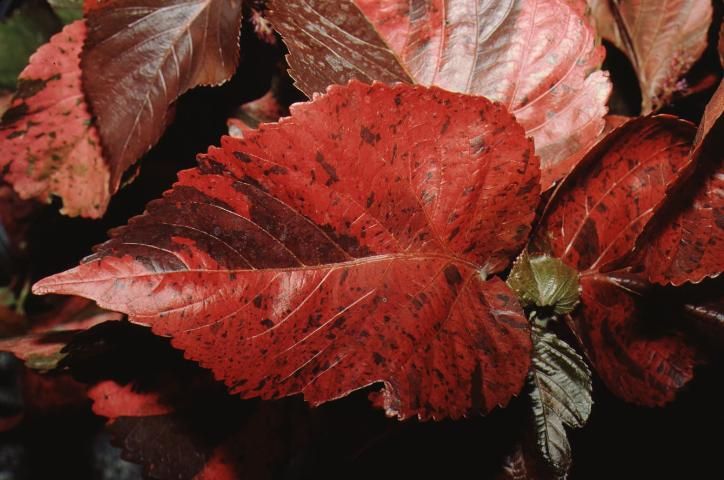Introduction
This large, fast-growing evergreen shrub provides a continuous splash of color in the landscape. The bronze red to muted red 4 to 8-inch-long, heart-shaped leaves are available in varying mottled combinations of green, purple, yellow, orange, pink, or white, depending upon cultivar. These colors make copperleaf difficult to blend into the landscape. Two or three shrubs are usually sufficient for specimen or accent plantings. Be careful not to over-plant with copperleaf. Their unusual color attracts attention and they could look gaudy. The dense, much-branched growth habit creates a full shape, but plants occasionally need shaping to maintain a neat appearance. The upright growth of copperleaf can reach 10 to 15 feet in height, making it well-suited to use as an accent in mixed shrubbery borders. Upright and side branches eventually droop, and the plant can spread to about 8 feet wide. The unusual, red, fuzzy, catkin-like flowers hang pendulously from leaf axils and are 8 to 12 inches long. It has been used as a hedge or screen planted on 3 to 5-foot centers.

Credit: Edward F. Gilman, UF/IFAS
General Information
Scientific name: Acalypha amentacea subsp. wilkesiana
Pronunciation: ack-uh-LIFE-uh a-ment-AY-see-ee subspecies wilk-see-AY-nuh
Common name(s): copperleaf, Jacob's coat, Wilkes' copperleaf
Family: Euphorbiaceae
Plant type: shrub
USDA hardiness zones: 10B through 11 (Figure 2)
Planting month for zone 10 and 11: year round
Origin: not native to North America
Invasive potential: not considered a problem species at this time and may be recommended by UF/IFAS faculty (reassess in 10 years)
Uses: hedge; border; mass planting; container or above-ground planter; screen; accent
Availablity: generally available in many areas within its hardiness range

=
Description
Height: 8 to 12 feet
Spread: 6 to 8 feet
Plant habit: round; upright
Plant density: dense
Growth rate: fast
Texture: coarse
Foliage
Leaf arrangement: alternate
Leaf type: simple
Leaf margin: dentate
Leaf shape: reniform
Leaf venation: pinnate
Leaf type and persistence: evergreen
Leaf blade length: 4 to 8 inches
Leaf color: purple or red; green; pink
Fall color: no fall color change
Fall characteristic: not showy
Flower
Flower color: red
Flower characteristic: summer flowering
Fruit
Fruit shape: unknown
Fruit length: unknown
Fruit cover: dry or hard
Fruit color: unknown
Fruit characteristic: inconspicuous and not showy
Trunk and Branches
Trunk/bark/branches: not particularly showy; typically multi-trunked or clumping stems
Current year stem/twig color: green
Current year stem/twig thickness: medium
Culture
Light requirement: plant grows in part shade/part sun
Soil tolerances: slightly alkaline; acidic; sand; loam; occasionally wet
Drought tolerance: moderate
Soil salt tolerance: unknown
Plant spacing: 36 to 60 inches
Other
Roots: usually not a problem
Winter interest: plant has winter interest due to unusual form, nice, persistent fruits, showy winter trunk, or winter flowers
Outstanding plant: not particularly outstanding
Pest resistance: long-term health usually not affected by pests
Use and Management
Copperleaf grows easily in full sun in frost-free locations. The plant branches less in partial shade. While tolerant of drought, it looks best when provided with regular watering during drought conditions. It will grow in a wide variety of garden soils.
A few of the available cultivars include 'Godseffiana,' green leaves with creamy-white margins; 'Macafeeana,' leaves red, marked crimson and bronze; 'Macrophylla,' russet-brown leaves; 'Marginata,' leaves margined with crimson or some other color; 'Miltoniana,' oblong, somewhat drooping leaves with irregularly cut, white margins; 'Musaica,' green leaves with orange and red markings; 'Obovata,' bronzy-green leaves with rosy-pink margins.
Copperleaf is easily propagated by air-layers or cuttings.
Design Considerations
The intense colors of the copperleaf foliage make a striking display in the landscape so it should be used with care. One to three plants carefully located for a dramatic focal point is the best use of the plant. Red shows best in full or part sun and would pair well with shrubs with medium green or dark green foliage. Small shrubs and groundcover plants with large dark green, glossy leaves would also contrast well with the foliage of the copperleaf plant. Pair with plants with simple forms, but contrasting texture such as mounding grasses with narrow strap blades or clumping form with wide-blade smooth foliage that is common on many tropical plants.
Pests and Diseases
Aphids, mites, and scales are problems on copperleaf plants.